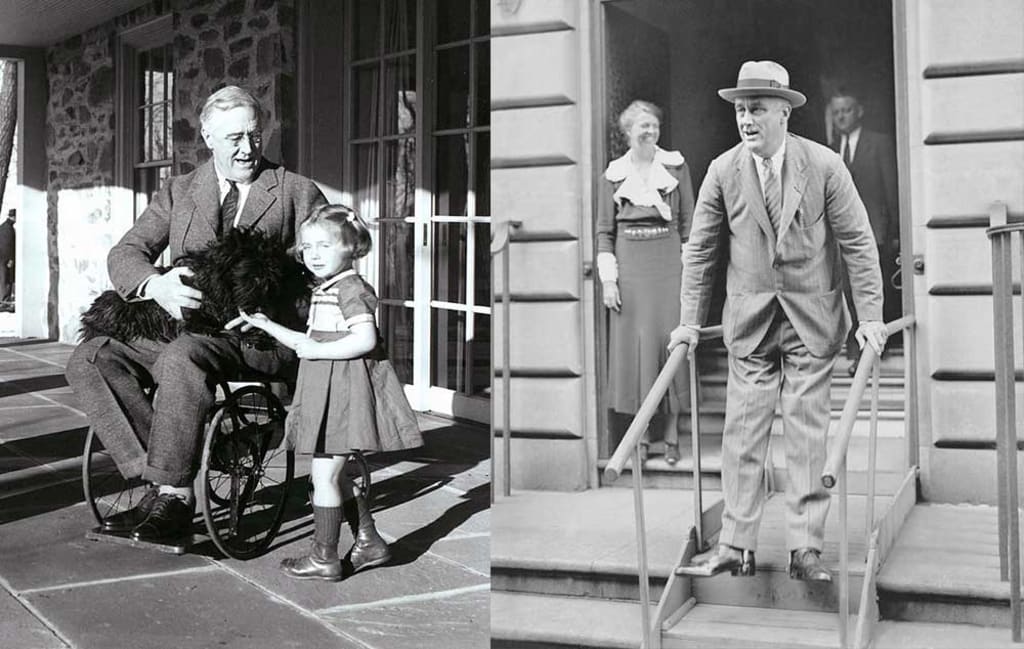How Franklin D. Roosevelt kept his paralysis from the American public — even while he was on the campaign trail.
In 1924, Roosevelt went back to running for office. Roosevelt spent most of his time in a wheelchair, but he could pretend to walk with the help of braces, crutches, and the steady arm of one of his sons. He made a wheelchair out of a kitchen chair. It was smaller than most wheelchairs at the time.

Franklin Delano Roosevelt is known as the president who led the country through the Great Depression and World War II, two of the biggest problems of the 20th century.
But the president's private struggle with his disability and the effort to keep the fact that he uses a wheelchair out of the public eye are less well known than his ability to handle serious crises.
In 1921, when Roosevelt was on vacation on Campobello Island, New Brunswick, he got polio, which left him paralyzed from the waist down.
Roosevelt was 39 years old at the time, and he was planning his political comeback after losing the 1920 presidential election as the vice-presidential candidate on the ticket of Democrat James M. Cox.
Roosevelt took himself out of the public eye to get better after he lost the ability to walk.

After years of practice, Roosevelt was able to walk short distances with the help of one or two people standing next to him while he wore metal leg braces. He also worked on getting stronger in his upper body.
After a few years, he went back into politics and became the governor of New York in 1928. In 1932, he was the first and, to this day, the only disabled person to be elected president.
The FDR Presidential Library and Museum says that a disabled politician was more accepted in America than he had thought. People were "sympathetic to his condition rather than embarrassed by it," the library says.
But Roosevelt was determined to keep pictures of him in a wheelchair out of the public eye. He was worried about how this would affect public opinion at a time when many people thought that a disability like this made it impossible for someone to hold a high office.

Secret Service agents would block the view of him when he was in a wheelchair, and if a journalist tried to get around this by taking a picture, they would take and destroy the picture.
But most reporters did what the White House asked and didn't take pictures of the president when he looked "disabled or weak."
He came up with a number of ways to hide his illness.
Roosevelt came up with a way to look like he was walking when he was in public. He would hold on to a friend or his son, carry a cane in the other hand, and swing his legs forward.
Another way to stay upright was to wear leg braces and tightly grip a lectern. This posture helped him develop the powerful head movements that were a big part of the way he spoke.
Hugh Gregory Gallagher, a historian, wrote that Roosevelt could only stay stable while standing at a podium by firmly gripping the podium and thrusting his pelvis forward so that his hip joints were hyperextended. However, in this position, he risked buckling at the hips and falling.
In 2013, an Indiana college professor named Ray Begovich was doing research at the National Archives when he found rare footage of President Roosevelt being pushed in his wheelchair.

It showed Roosevelt being pushed down a ramp by sailors in July 1944, after he had visited the USS Baltimore in Pearl Harbour. His wheelchair was partly hidden by the sailors.
Begovich, a journalism professor at Franklin College, told the Associated Press at the time, "This raw film clip may be the first moving picture images of the president in his wheelchair, and it was never meant to be shown to the world."
Roosevelt died in office in 1945, and most people still didn't know about his illness.
"During his time in the White House, hundreds of thousands, if not millions, of people saw him up close, and most did not notice that he had a physical disability," Gregory Gallagher wrote.
Some experts have said that Roosevelt was ashamed of his disability.
For some historians, the fact that he didn't let polio define him was a big part of what made him an underdog to American voters and what made him strong.
In Warm Springs, Georgia, where he got help in the 1920s, he even helped build one of the first modern rehabilitation centers.

"I think he was that man before he got sick, but he didn't know who he really was until he went through the ordeal of polio," author and historian James Tobin told NPR. "It gave him a kind of confidence in his own strength that maybe no one can have until they're tested."
In 2001, a statue of Roosevelt in his wheelchair was unveiled in Washington, D.C. This was an image that Roosevelt had tried to hide from the public for a long time. On the wall behind the statue, Eleanor Roosevelt's words about her disabled husband are written.
"Franklin's illness gave him strength and courage he hadn't had before. He had to figure out the basics of life and learn the most important lesson of all: to be patient and never give up."
About the Creator
Rare Stories
Our goal is to give you stories that will have you hooked.
This is an extension of the Quora space: Rare Stories
X(formerly Twitter): Scarce Stories
Official Bookstore: davidkellertruecrime
Writers:
....xoxo






Comments
There are no comments for this story
Be the first to respond and start the conversation.